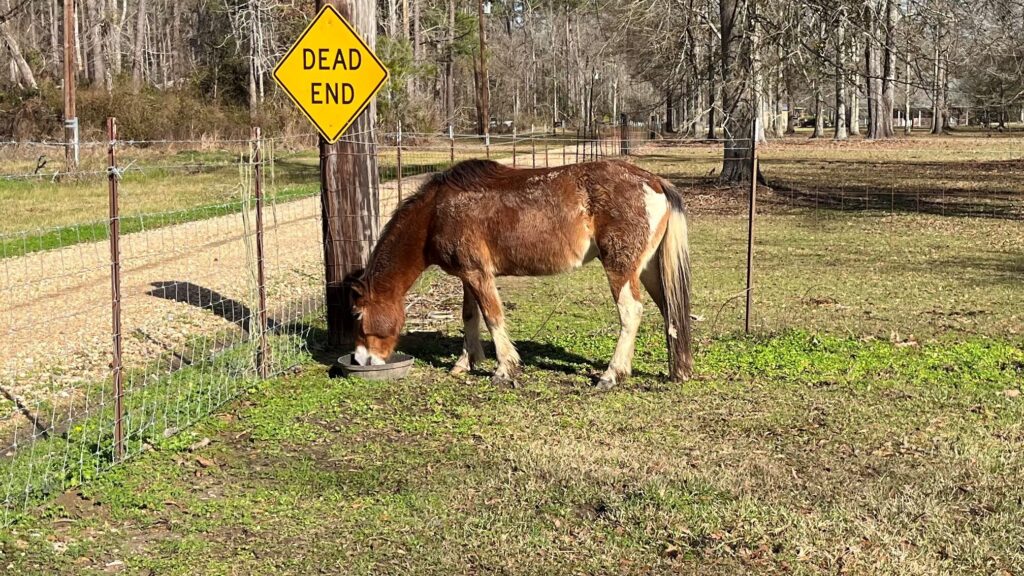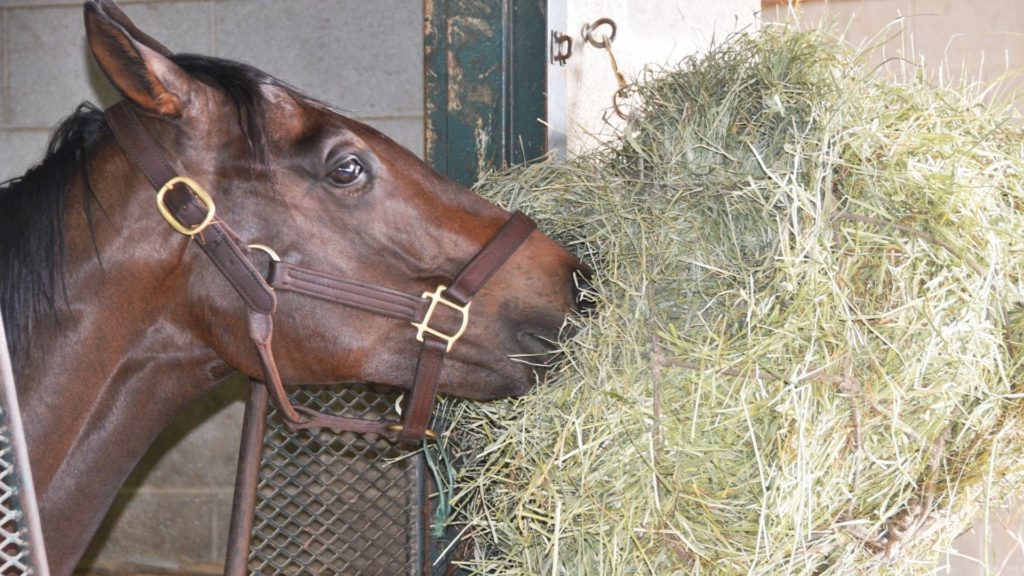Last updated: September 16, 2024
As a lifelong horse owner with seven horses currently in training, I’ve seen the importance of thoughtful feeding practices firsthand. One question frequently sparks debate among horse enthusiasts is whether to feed hay and grain on the ground or at chest level.
In this comprehensive guide, we’ll delve into the pros and cons of each method, explore the factors influencing your decision, and help you find the best approach for your equine companions.

Understanding a Horse’s Natural Feeding Behavior
Horses are grazing animals, designed to spend most of their day foraging for food at ground level. This natural posture offers several benefits, including:
- Improved digestion: Eating with their heads down stimulates saliva production, which aids food breakdown and helps prevent choke.
- Reduced respiratory issues: Grazing minimizes dust inhalation, protecting their sensitive respiratory system.
- Natural teeth wear: The grinding action involved in grazing helps maintain proper tooth wear patterns.
Mimicking these natural behaviors is crucial for a horse’s overall health and well-being.

The Pros and Cons of Ground-Level Feeding
Ground-level feeding closely resembles a horse’s natural grazing behavior and comes with several advantages:
- Promotes natural posture and digestion: As mentioned above, ground-level feeding encourages the natural head-down position, aiding digestion and reducing the risk of respiratory problems. The University of Minnesota Extension confirms that ground feeding promotes saliva production, essential for proper digestion and nutrient absorption. https://extension.umn.edu/horse/horse-nutrition
- May lower the risk of choke and colic: Slowing down a horse’s eating pace can reduce the chances of choke, while increased saliva production can help prevent colic. Studies from Rutgers University have shown a correlation between feeding height and the incidence of choke in horses. https://extension.umn.edu/horse/horse-care-and-management
- Encourages natural wear patterns on teeth: Grazing on the ground helps maintain proper tooth wear patterns, reducing the need for frequent dental interventions.
However, ground-level feeding also has some drawbacks:
- Potential for hay contamination: Hay can become contaminated with dirt, parasites, and manure when placed on the ground.
- Can be challenging for some horses: Older horses or those with dental or mobility issues may struggle to eat comfortably from the ground.
- Requires more frequent cleaning: Feeding areas need to be cleaned regularly to prevent the build-up of debris and contamination.

The Pros and Cons of Raised Feeding (Chest-Level)
Raised feeding, typically at chest height, offers certain advantages:
- Can be more comfortable for some horses: Older horses or those with neck or back problems might find it easier to eat from a raised feeder.
- Reduces hay waste and contamination: Elevated feeders keep hay off the ground, minimizing waste and contamination.
- Convenient for horse owners: Raised feeders are generally easier to manage and refill.
However, raised feeding also has its disadvantages:
- Can alter natural posture: Eating with their heads elevated can cause muscle strain and potentially lead to long-term health issues. A study published in the Journal of Equine Veterinary Science found that feeding at chest level can alter a horse’s natural head and neck posture.
- May increase dust inhalation: Depending on the feeder design and hay quality, raised feeding can increase dust exposure, leading to respiratory problems.
- Not ideal for all horses: Horses prone to choke or digestive problems may struggle with raised feeding.

Factors to Consider When Choosing a Feeding Height
There’s no one-size-fits-all answer to the feeding height question. The best approach depends on several factors:
- Age and Health Status: Consider your horse’s individual needs. Older horses or those with health issues may benefit from raised feeding, while younger, healthy horses are generally better suited to ground-level feeding.
- Individual Horse Preferences: Observe your horse’s behavior and preferences when eating at different heights. Some horses may naturally prefer one method over the other.
- Management Practices: Consider the available space, cleaning routines, and the type of hay being fed. If hay quality is a concern, raised feeding may be preferable to reduce contamination.
- Expert Advice: Consult your veterinarian or an equine nutritionist for personalized recommendations based on your horse’s specific needs.

Finding the Right Balance: Hybrid Feeding Options
In some cases, a hybrid approach combining ground-level and raised feeding options might be the best solution. Here are some strategies to consider:
- Slow Feeders: These devices on the ground can slow down a horse’s eating pace and mimic natural grazing behavior.
- Hay Nets: Hanging hay nets at various heights can provide a compromise between ground-level and raised feeding.
- Raised Platforms: Building a raised platform with ground-level access allows horses to choose their preferred feeding position.
Remember, flexibility is key. Be willing to adapt your feeding practices to suit each horse’s individual needs and preferences.
Frequently Asked Questions about Ground versus Raised Feeding Horses.
Is ground feeding better for horses than raised feeding?
Ground feeding is generally considered closer to a horse’s natural grazing behavior and can offer benefits for digestion, respiratory health, and dental wear. However, it may not be suitable for all horses, especially those with health issues or mobility limitations.
What are the advantages of raised feeding?
Raised feeding can be more comfortable for older horses or those with specific health concerns. It also reduces hay waste and contamination.
Can I combine ground-level and raised feeding for my horse?
Absolutely! A hybrid approach using slow feeders, hay nets, or raised platforms with ground-level access can offer the benefits of both methods and cater to your horse’s individual needs.
How do I know which feeding method is best for my horse?
Consider your horse’s age, health status, and individual preferences. Observe their behavior and consult with your veterinarian or an equine nutritionist for personalized advice.
Is it okay to change my horse’s feeding method?
Yes, you can adjust your horse’s feeding method as needed. Be observant of any changes in their behavior or health and make adjustments accordingly.
Conclusion
The debate over raised vs. ground feeding for horses is likely to continue. However, by understanding your horse’s natural behavior and prioritizing their health and well-being, you can make informed decisions about their feeding practices.
As a horse owner and trainer, I’ve found that observing my horses and adapting my approach based on their individual needs has been the most successful strategy. Whether you choose ground-level, raised, or a hybrid approach, ensure that your horse has access to plenty of fresh, clean forage and that their feeding environment is safe and comfortable.
What are your experiences with ground-level vs. raised feeding? Share your insights and questions in the comments below!
Remember, the best feeding method supports your horse’s natural instincts, promotes its health, and meets its individual needs.

About the Author: Miles Henry
Lifelong Horseman | Racehorse Owner | Published Author
Miles Henry brings over 25 years of hands-on experience training and owning Thoroughbred racehorses. Raised with Quarter Horses and Appaloosas, he’s spent a lifetime learning from horses—on the track, in the barn, and in the field. Today, he runs a small but successful racing stable in Louisiana and shares real-world insights on HorseRacingSense.com, helping horse owners, fans, and bettors navigate the sport with confidence.
📚 Books: View Miles’s books on Amazon »
🎧 Podcast Guest: Animal Tales Ep. 32 |
YouTube Interview
📩 Newsletter: Sign up for racing tips and horse care advice »
🔗 Follow Miles:
Twitter |
Facebook |
YouTube

